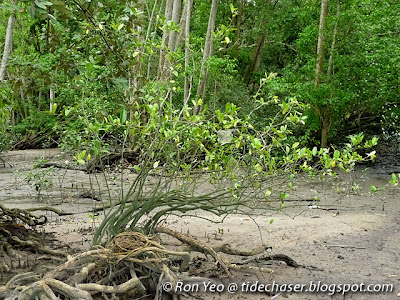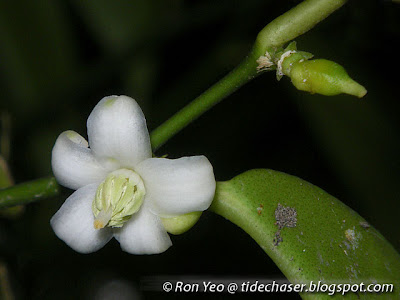The Mangrove Lime (Merope angulata) is a critically endangered mangrove associate in Singapore.

Personally, I have seen the biggest population of this plant at the back mangrove along Kranji Nature Trail, with more than 20 plants. Mandai Mangrove also has a good population, while at Sungei Buloh, I have seen 2 young plants just next to the boardwalk, and another cluster in the middle of the mangrove with more than 10 plants. Not sure if they can be found else where in Singapore, though I would assume they should be present in the other northern mangroves.

The plant typically occurs as a a shrub in Singapore, and the tallest that I have seen is about 2m. It is found to the landward edge of mangrove forests and along river banks, and generally in areas with firm substrate.

It has alternate leaves, as seen on this young plant found at Sungei Buloh. The leaves, especially the more mature ones, tend to be thick and leathery, and aromatic (lime like fragrance) when broken.

The leaves are dotted with tiny glands, as shown on the leaf to the lower-right of the above photo, which also has a flower and a young fruit.

Here's a look at the flower bud.

The flowers, which occur in leaf axils, are fragrant with 5 white petals and 10 stamens. They usually occur in pairs or small clusters.

The fruit is triangular in cross-section with 3 flattened sides.

The fruits turn yellow as they mature.

Like other plants from the family Rutaceae, the branches come with woody thorns. Interestingly, the Malay name for the plant, Limau Lelang, means "lime" (limau) and "hawk's talons" (lelang, refering to the thorns. The tree appears to be deciduous to me, as on several occasions I had seen all the leaves on a plant turning yellow and dropping off, but yet during subsequent visits, they were all green again.
The roots are said to be used to treat abdominal complaints and assist womb contract after childbirth. Locals sometimes preserve the fruits and boil them to make a citrus drink.
References

Personally, I have seen the biggest population of this plant at the back mangrove along Kranji Nature Trail, with more than 20 plants. Mandai Mangrove also has a good population, while at Sungei Buloh, I have seen 2 young plants just next to the boardwalk, and another cluster in the middle of the mangrove with more than 10 plants. Not sure if they can be found else where in Singapore, though I would assume they should be present in the other northern mangroves.

The plant typically occurs as a a shrub in Singapore, and the tallest that I have seen is about 2m. It is found to the landward edge of mangrove forests and along river banks, and generally in areas with firm substrate.

It has alternate leaves, as seen on this young plant found at Sungei Buloh. The leaves, especially the more mature ones, tend to be thick and leathery, and aromatic (lime like fragrance) when broken.

The leaves are dotted with tiny glands, as shown on the leaf to the lower-right of the above photo, which also has a flower and a young fruit.

Here's a look at the flower bud.

The flowers, which occur in leaf axils, are fragrant with 5 white petals and 10 stamens. They usually occur in pairs or small clusters.

The fruit is triangular in cross-section with 3 flattened sides.

The fruits turn yellow as they mature.

Like other plants from the family Rutaceae, the branches come with woody thorns. Interestingly, the Malay name for the plant, Limau Lelang, means "lime" (limau) and "hawk's talons" (lelang, refering to the thorns. The tree appears to be deciduous to me, as on several occasions I had seen all the leaves on a plant turning yellow and dropping off, but yet during subsequent visits, they were all green again.
The roots are said to be used to treat abdominal complaints and assist womb contract after childbirth. Locals sometimes preserve the fruits and boil them to make a citrus drink.
References
- Chong, K. Y., H. T. W. Tan & R. T. Corlett, 2009. A Checklist of the Total Vascular Plant Flora of Singapore: Native, Naturalised and Cultivated Species. Raffles Museum of Biodiversity Research, National University of Singapore. Singapore. 273 pp.
- Giesen, W., S. Wulffraat, M. Zieren & L. Scholten. 2006. Mangrove guidebook for Southeast Asia. RAP Publication 2006/07. FAO Regional Office for Asia and the Pacific & Wetlands International. Bangkok. 769 pp.
- Ng, P. K. L., and N. Sivasothi. 1999. A guide to the mangroves of Singapore 1 : the ecosystem & plant diversity. Singapore Science Centre. Singapore. 168 pp.

No comments:
Post a Comment